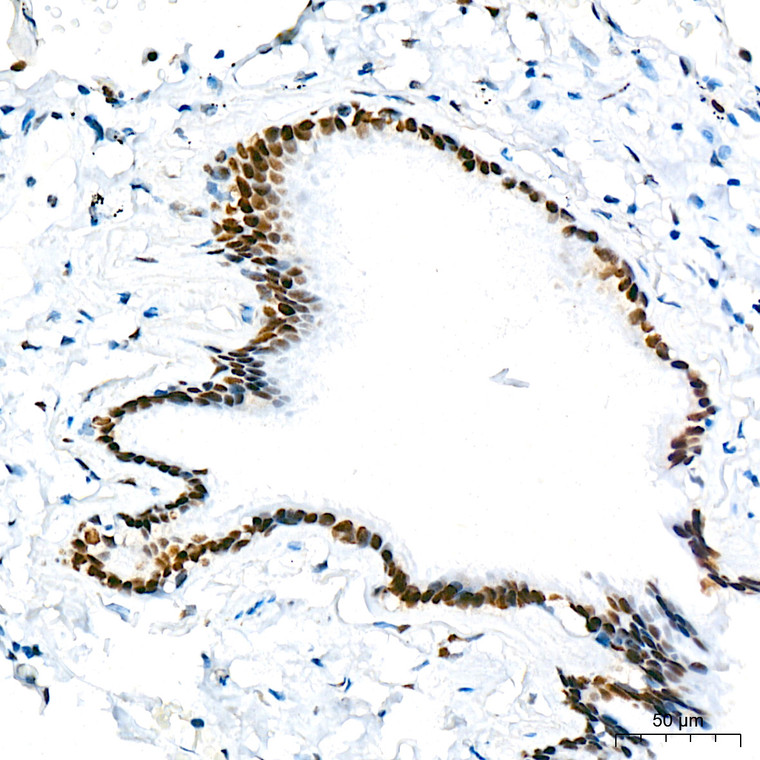-
Western blot analysis of extracts of various cell lines, using TARBP2 rabbit monoclonal antibody (STJ11102424) at 1:1000 dilution. Secondary antibody: HRP Goat Anti-rabbit IgG (H+L) at 1:10000 dilution. Lysates/proteins: 25ug per lane. Blocking buffer: 3% non-fat dry milk in TBST. Detection: ECL Basic Kit. Exposure time: 3min.
-
Confocal imaging of U-2 OS cells using TARBP2 Rabbit monoclonal antibody (STJ11102424, dilution 1:200) followed by a further incubation with Cy3 Goat Anti-Rabbit IgG (H+L) ( dilution 1:500) (Red). The cells were counterstained with Alpha-Tubulin Mouse monoclonal antibody ( dilution 1:400) followed by incubation with ABflo® 488-conjugated Goat Anti-Mouse IgG (H+L) antibody ( dilution 1:500) (Green). DAPI was used for nuclear staining (Blue). Objective: 100x.
-
Immunohistochemistry of paraffin-embedded rat pancreas using TARBP2 rabbit monoclonal antibody (STJ11102424) at dilution of 1:100 (40x lens).
-
Confocal imaging of NIH/3T3 cells using TARBP2 Rabbit monoclonal antibody (STJ11102424, dilution 1:200) followed by a further incubation with Cy3 Goat Anti-Rabbit IgG (H+L) ( dilution 1:500) (Red). The cells were counterstained with Alpha-Tubulin Mouse monoclonal antibody ( dilution 1:400) followed by incubation with ABflo® 488-conjugated Goat Anti-Mouse IgG (H+L) antibody ( dilution 1:500) (Green). DAPI was used for nuclear staining (Blue). Objective: 100x.
-
Immunohistochemistry of paraffin-embedded human placenta using TARBP2 rabbit monoclonal antibody (STJ11102424) at dilution of 1:100 (40x lens).
-
Confocal imaging of paraffin-embedded Mouse brain tissue using TARBP2 Rabbit monoclonal antibody (STJ11102424, dilution 1:200) followed by a further incubation with Cy3 Goat Anti-Rabbit IgG (H+L) ( dilution 1:500) (Red). DAPI was used for nuclear staining (Blue). Objective: 40x. Perform microwave antigen retrieval with 0. 01 M citrate buffer (pH 6. 0) prior to IF staining.
-
Immunohistochemistry of paraffin-embedded mouse pancreas using TARBP2 rabbit monoclonal antibody (STJ11102424) at dilution of 1:100 (40x lens).
-
Immunohistochemistry analysis of TARBP2 in paraffin-embedded mouse lung tissue using TARBP2 Rabbit monoclonal antibody (STJ11102424) at a dilution of 1:200 (40x lens). High pressure antigen retrieval was performed with 0. 01 M citrate buffer (pH 6. 0) prior to immunohistochemistry staining.
-
Immunofluorescence analysis of NIH-3T3 cells using TARBP2 rabbit monoclonal antibody (STJ11102424) at dilution of 1:100 (40x lens). Blue: DAPI for nuclear staining.
-
Immunohistochemistry analysis of TARBP2 in paraffin-embedded mouse kidney tissue using TARBP2 Rabbit monoclonal antibody (STJ11102424) at a dilution of 1:200 (40x lens). High pressure antigen retrieval was performed with 0. 01 M citrate buffer (pH 6. 0) prior to immunohistochemistry staining.
-
Immunofluorescence analysis of U-2 OS cells using TARBP2 rabbit monoclonal antibody (STJ11102424) at dilution of 1:100 (40x lens). Blue: DAPI for nuclear staining.
-
Immunohistochemistry analysis of TARBP2 in paraffin-embedded human lung cancer tissue using TARBP2 Rabbit monoclonal antibody (STJ11102424) at a dilution of 1:200 (40x lens). High pressure antigen retrieval was performed with 0. 01 M citrate buffer (pH 6. 0) prior to immunohistochemistry staining.
-
Immunohistochemistry analysis of TARBP2 in paraffin-embedded human thyroid cancer tissue using TARBP2 Rabbit monoclonal antibody (STJ11102424) at a dilution of 1:200 (40x lens). High pressure antigen retrieval was performed with 0. 01 M citrate buffer (pH 6. 0) prior to immunohistochemistry staining.
-
Immunohistochemistry analysis of TARBP2 in paraffin-embedded human liver tissue using TARBP2 Rabbit monoclonal antibody (STJ11102424) at a dilution of 1:200 (40x lens). High pressure antigen retrieval was performed with 0. 01 M citrate buffer (pH 6. 0) prior to immunohistochemistry staining.
-
Immunohistochemistry analysis of TARBP2 in paraffin-embedded human lung tissue using TARBP2 Rabbit monoclonal antibody (STJ11102424) at a dilution of 1:200 (40x lens). High pressure antigen retrieval was performed with 0. 01 M citrate buffer (pH 6. 0) prior to immunohistochemistry staining.
-
Immunohistochemistry analysis of TARBP2 in paraffin-embedded rat brain tissue using TARBP2 Rabbit monoclonal antibody (STJ11102424) at a dilution of 1:200 (40x lens). High pressure antigen retrieval was performed with 0. 01 M citrate buffer (pH 6. 0) prior to immunohistochemistry staining.
-
Western blot analysis of various lysates using TARBP2 Rabbit monoclonal antibody (STJ11102424) at 1:1000 dilution. Secondary antibody: HRP Goat Anti-Rabbit IgG (H+L) (STJS000856) at 1:10000 dilution. Lysates/proteins: 25 Mu g per lane. Blocking buffer: 3% nonfat dry milk in TBST. Detection: ECL Enhanced Kit. Exposure time: 3min.























